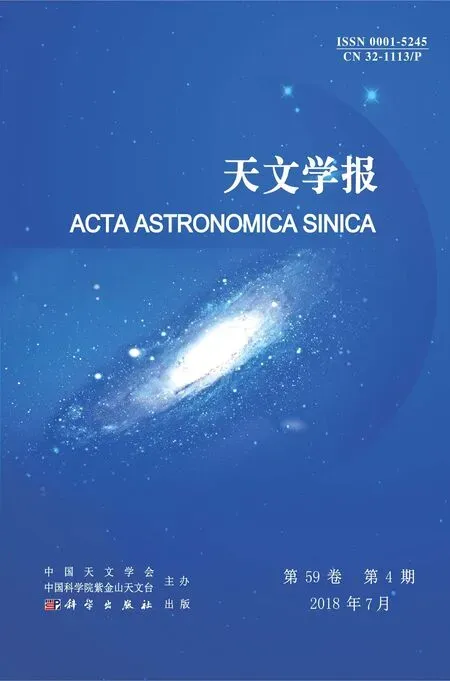射电星系的中央引擎和统一模型研究
胡京馥
(中国科学院上海天文台上海200030)
活动星系核是一类存在着剧烈物理过程的天体,从射电到高能辐射的全电磁波段都有均匀辐射,这使得它成为各个波段探测的重要对象.活动星系核的高光度使得我们能够对高红移天体的光谱进行细致研究.因此,研究活动星系核对于理解星系的形成、结构和演化有重要意义.目前,活动星系核的研究已经成为现代天体物理研究的热点之一.
活动星系核中大约有10%是射电噪的,伴随着相对论性喷流.射电星系根据形态的不同可以分为FR I和FR II两种,其中FR I是边缘暗的射电结构,而FR II是在边缘增亮型射电结构,在射电瓣的边缘处可以看到明亮的热斑.FR II的射电功率通常高于FR I,在P178MHz=1025W/Hz处分界.目前,导致它们在观测上表现出不同的原因并不清楚,部分原因是喷流与周围介质的相互作用导致的,也可能是因为FR I和FR II的中央引擎吸积模式不同导致的.其实,射电星系除了可以根据射电形态进行分类之外,还可以根据其光学光谱分成高激发射电星系和低激发射电星系两种:其中,高激发星系的[O III]/Hα>0.2以及[O III]发射线的等值宽度EW>3˚A,而低激发星系的[O III]发射线相对较弱.射电星系的两种分类不是完全一致的,虽然高激发星系的核光度普遍高于低激发星系,但是仍有小部分低激发星系是明亮的射电源,并且具有典型的FR II射电形态.
在第2章中,我们选取了111个红移小于0.3的射电星系并研究他们的活动核中心性质.样本中黑洞的质量是利用寄主星系的速度弥散以及宽线区发射线的宽度估计的.我们统计发现表征高低激发线相对强度的激发指数和爱丁顿比之间呈现明显的正相关.考虑到窄发射线区的尺度与光度之间的经验关系我们利用CLOUDY程序作了光致电离模型计算发现,理论结果与观测结果相符合.模型计算中我们讨论了带有明显大蓝包和没有大蓝包两种不同的SED模板,但是模型计算结果显示其对SED谱形并不敏感.这意味着低激发星系和高激发星系之间的不同性质并不是吸积模型的不同导致的.我们认为,也许这两类星系之间的不同是由于窄线区尺度的不同造成的.活动星系核的统一模型认为所有的活动星系核都有相同的基本结构:中央超大质量黑洞、吸积盘以及在某些观测方向能遮挡中心核辐射的尘埃环.据此,可以将活动星系核分成两类:可以直接观测到吸积盘辐射的I型活动星系核(光学光谱中具有明显宽发射线)和宽线区被尘埃环遮挡的II型活动星系核,其光学光谱中只能观测到窄发射线.
曹新伍等(见Cao X W,Rawlings S.MNRAS,2004,349:1419)通过研究一个3CR的射电星系样本发现,FR I射电源的喷流功率大于理论上ADAF吸积盘可以得到的最大喷流功率,因此他们认为这些FR I射电星系的吸积模式是标准薄盘而不是ADAF,其光学核和宽线区是被尘埃环遮挡了.为了检验这些源是否存在尘埃环,第3章中我们用CLOUDY程序模拟3C 288射电源的光致电离模型,发现理论得到的电离光度大于实际观测到的光学核光度,[O III]发射线光度的理论值高于观测值,这说明在3C 288中确实存在遮挡效应.为了进一步检验这个结论,本章又根据尘埃消光来验证高喷流射电功率星系3C288中的遮挡效应是尘埃环造成的.
Active galactic nucleus is a kind of astronomical object with dramatic physical processes.Their radiation covers from radio to high-energy bands,which makes it become an important object for research at all electromagnetic bands.The high luminosities of active galactic nucleus enable us to proceed a detailed spectroscopic research of the objects at high redshift.The central structures and activities of active galactic nucleus are important for understanding the formation,structure,and evolution of galaxies.At present,the research of active galactic nuclei has become one of hot topics in the modern astrophysics.
About 10%of the active galactic nuclei are radio-loud,showing a highly collimated,relativistic radio jet.Radio galaxies are classified as FR I or FR II sources according to their radio morphology.FR I radio galaxies have edge-darkened radio structure,while FR II galaxies are de fined by edge-brightened radio jets terminating in compact hot spots.The jet power of FR II radio galaxies is systematically higher than FR Is.The transition luminosity for FR I/II is at P178MHz=1025W/Hz.So far the reason of such difference between FR I and FR II galaxies is still unclear.There are different interpretations for the FR dichotomy,such as,the interaction of the jet with the ambient medium or the intrinsic nuclei properties of accretion.Besides the FR I/II dichotomy,radio galaxies can also be classified by their spectroscopic nuclear properties into high excitation galaxies(HEG)and low excitation galaxies(LEG):high excitation galaxies have[O III]/Hα>0.2 and equivalent width(EW)of[O III]>3˚A,while LEGs have relatively weaker[O III].The two classification methods are not consistent.Although HEGs have systematically higher nuclear luminosities than LEGs,a few LEGs are bright radio sources and have typical FR II morphology distinguishable from HEGs.
In chapter 2,we use a sample of 111 radio galaxies with redshift z<0.3 to investigate their nuclear properties.The black hole masses of the sources in this sample are estimated with the velocity dispersion of the galaxies,or the width of the broad-lines.We find that the excitation index,or the relative intensity of low and high excitation lines,is correlated with the Eddington ratio for this sample.Considering of the empirical relation between the size of the narrow-line region(NLR)and the ionizing luminositywe find that the correlation between the excitation index and the Eddington ratio can be reproduced by the photoionization models using CLOUDY.We adopt two sets of spectral energy distributions(SEDs),with or without a big blue bump in ultraviolet as the ionizing continuum,and find that the modelled correlation between the excitation index and the Eddington ratio is insensitive to the used SED.This means that the difference between high and low excitation galaxies is not caused by the different accretion modes in these sources.Instead,it may be caused by the NLR size.
The unified model of active galactic nuclei(AGN)proposes that all AGNs are composed of the same basic ingredients:a super massive black hole and accretion disk,surrounded bya toroidal mass of dust and gas that obscures the nucleus from some lines of sight.Active galactic nucleus can be separated into “Type 1” objects and “Type 2”objects. “Type 1”objects(those with very broad emission lines in their optical spectra)are those in which we have a direct view of the hot,fast-moving material close to the accretion disk.In “Type 2”objects the torus obscures this material,and we see only narrow emission lines in the optical spectra.
Cao et al.(see Cao X W,Rawlings S.MNRAS,2004,349:1419)analyzed the optical and radio properties of a sample of 3CR FR I radio galaxies,and found that the jet power for more than one-third of the sources in the sample is greater than the maximal jet power extracted from a rapid spinning black hole with advection dominated accretion flow(ADAF)accretion disk.They argued that a significant fraction,at least for the highjet-power sources,of 3CR FR I radio galaxies have standard thin discs,but their optical core and broad line regions can be hidden by torus.In order to examine the existence of torus in the high-jet power sources,we carry out the photoionization model calculations for the radio galaxy 3C 288 using CLOUDY in chapter 3.We found that the theoretical ionizing luminosity is larger than the observed optical core luminosity,as well as the[O III]luminosity.Further,we also calculate the column density by dust extinction.We conclude that there is indeed obscuring torus in 3C288.

